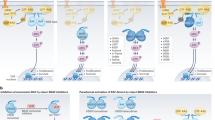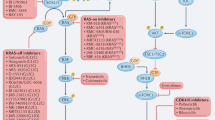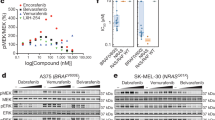Abstract
B-RAF is the most frequently mutated protein kinase in human cancers1. The finding that oncogenic mutations in BRAF are common in melanoma2, followed by the demonstration that these tumours are dependent on the RAF/MEK/ERK pathway3, offered hope that inhibition of B-RAF kinase activity could benefit melanoma patients. Herein, we describe the structure-guided discovery of PLX4032 (RG7204), a potent inhibitor of oncogenic B-RAF kinase activity. Preclinical experiments demonstrated that PLX4032 selectively blocked the RAF/MEK/ERK pathway in BRAF mutant cells and caused regression of BRAF mutant xenografts4. Toxicology studies confirmed a wide safety margin consistent with the high degree of selectivity, enabling Phase 1 clinical trials using a crystalline formulation of PLX4032 (ref. 5). In a subset of melanoma patients, pathway inhibition was monitored in paired biopsy specimens collected before treatment initiation and following two weeks of treatment. This analysis revealed substantial inhibition of ERK phosphorylation, yet clinical evaluation did not show tumour regressions. At higher drug exposures afforded by a new amorphous drug formulation4,5, greater than 80% inhibition of ERK phosphorylation in the tumours of patients correlated with clinical response. Indeed, the Phase 1 clinical data revealed a remarkably high 81% response rate in metastatic melanoma patients treated at an oral dose of 960 mg twice daily5. These data demonstrate that BRAF-mutant melanomas are highly dependent on B-RAF kinase activity.
This is a preview of subscription content, access via your institution
Access options
Subscribe to this journal
Receive 51 print issues and online access
$199.00 per year
only $3.90 per issue
Buy this article
- Purchase on Springer Link
- Instant access to full article PDF
Prices may be subject to local taxes which are calculated during checkout




Similar content being viewed by others
References
Greenman, C. et al. Patterns of somatic mutation in human cancer genomes. Nature 446, 153–158 (2007)
Davies, H. et al. Mutations of the BRAF gene in human cancer. Nature 417, 949–954 (2002)
Solit, D. B. et al. BRAF mutation predicts sensitivity to MEK inhibition. Nature 439, 358–362 (2006)
Yang, H. et al. RG7204 (PLX4032), a selective BRAFV600E inhibitor, displays potent antitumor activity in preclinical melanoma models. Cancer Res. 70, 5518–5527 (2010)
Flaherty, K. et al. Inhibition of mutated, activated BRAF in metastatic melanoma. N. Engl. J. Med. 363, 809–819 (2010)
Tsai, J. et al. Discovery of a selective inhibitor of oncogenic B-Raf kinase with potent antimelanoma activity. Proc. Natl Acad. Sci. USA 105, 3041–3046 (2008)
Hatzivassiliou, G. et al. RAF inhibitors prime wild-type RAF to activate the MAPK pathway and enhance growth. Nature 464, 431–435 (2010)
Koch, W. H. Technology platforms for pharmacogenomic diagnostic assays. Nature Rev. Drug Discov. 3, 749–761 (2004)
Rubinstein, J. C. et al. Incidence of the V600K mutation among melanoma patients with BRAF mutations, and potential therapeutic response to the specific BRAF inhibitor PLX4032. J. Transl. Med. 8, 67 (2010)
Esteve-Puig, R., Canals, F., Colome, N., Merlino, G. & Recio, J. A. Uncoupling of the LKB1-AMPKα energy sensor pathway by growth factors and oncogenic BRAFV600E . PLoS ONE 4, e4771 (2009)
Zheng, B. et al. Oncogenic B-RAF negatively regulates the tumor suppressor LKB1 to promote melanoma cell proliferation. Mol. Cell 33, 237–247 (2009)
Søndergaard, J. N. et al. Differential sensitivity of melanoma cell lines with BRAFV600E mutation to the specific B-Raf inhibitor PLX4032. J. Transl. Med. 8, 39 (2010)
Arnault, J. P. et al. Keratoacanthomas and squamous cell carcinomas in patients receiving sorafenib. J. Clin. Oncol. 27, e59–e61 (2009)
Dubauskas, Z. et al. Cutaneous squamous cell carcinoma and inflammation of actinic keratoses associated with sorafenib. Clin. Genitourin. Cancer 7, 20–23 (2009)
Kong, H. H. et al. Keratoacanthomas associated with sorafenib therapy. J. Am. Acad. Dermatol. 56, 171–172 (2007)
Schwartz, G. K. et al. A phase I study of XL281, a selective oral RAF kinase inhibitor, in patients (Pts) with advanced solid tumors. J. Clin. Oncol. 27, 3513 (suppl.), (2009)
Kefford, R. et al. Phase I/II study of GSK2118436, a selective inhibitor of oncogenic mutant BRAF kinase, in patients with metastatic melanoma and other solid tumors. J. Clin. Oncol. 28, 8503 (suppl.), (2010)
Heidorn, S. J. et al. Kinase-dead BRAF and oncogenic RAS cooperate to drive tumor progression through CRAF. Cell 140, 209–221 (2010)
Poulikakos, P. I., Zhang, C., Bollag, G., Shokat, K. M. & Rosen, N. RAF inhibitors transactivate RAF dimers and ERK signalling in cells with wild-type BRAF. Nature 464, 427–430 (2010)
Courtois-Cox, S. et al. A negative feedback signaling network underlies oncogene-induced senescence. Cancer Cell 10, 459–472 (2006)
Dougherty, M. K. et al. Regulation of Raf-1 by direct feedback phosphorylation. Mol. Cell 17, 215–224 (2005)
Hall-Jackson, C. A. et al. Paradoxical activation of Raf by a novel Raf inhibitor. Chem. Biol. 6, 559–568 (1999)
Rajakulendran, T., Sahmi, M., Lefrancois, M., Sicheri, F. & Therrien, M. A dimerization-dependent mechanism drives RAF catalytic activation. Nature 461, 542–545 (2009)
Pratilas, C. A. et al. V600EBRAF is associated with disabled feedback inhibition of RAF-MEK signaling and elevated transcriptional output of the pathway. Proc. Natl Acad. Sci. USA 106, 4519–4524 (2009)
Kolch, W. Coordinating ERK/MAPK signalling through scaffolds and inhibitors. Nature Rev. Mol. Cell Biol. 6, 827–837 (2005)
Pollock, P. M. et al. High frequency of BRAF mutations in nevi. Nature Genet. 33, 19–20 (2003)
Michaloglou, C. et al. BRAFE600-associated senescence-like cell cycle arrest of human naevi. Nature 436, 720–724 (2005)
Korn, E. L. et al. Meta-analysis of phase II cooperative group trials in metastatic stage IV melanoma to determine progression-free and overall survival benchmarks for future phase II trials. J. Clin. Oncol. 26, 527–534 (2008)
Acknowledgements
We thank L. Andries and M. Knaapen from HistoGeneX for evaluating paired biopsies, and also our colleagues at the Molecular Imaging Research division of Charles River Labs for conducting the xenograft studies. We also thank D. Heimbrook, S. Cheng, L. Burdette and B. Lestini for helpful comments on the manuscript. This research was funded in part by NIH grants to K.L.N.
Author information
Authors and Affiliations
Contributions
G.B., P.H., C.Z., K.L.N. and K.N. designed studies, interpreted data and wrote the manuscript. J.T., G.H., E.A.B., B.W., G.T., B.L.W., B.P., R.S., A.M., H.N., F.S., and B.H. conducted or managed biochemical or biological studies. J.Z., P.N.I., H.C., W.S., D.R.A. and R.I. designed and conducted chemistry and formulation experiments. Y.Z. and K.Y.J.Z. conducted and interpreted structural studies. J.S. helped interpret data and write the manuscript. K.D., A.K., M.S. and X.X. designed, managed and interpreted biomarker studies. P.S.L., R.J.L., J.G., I.P., K.B.K., A.R., G.A.M., J.A.S., P.B.C. and K.T.F. managed or conducted clinical and translational studies.
Corresponding author
Ethics declarations
Competing interests
[Many of the authors are employed by the biotechnology company Plexxikon or the pharmaceutical company Roche, as indicated in the author affiliations.]
Supplementary information
Supplementary Information
This file contains Supplementary Methods, Supplementary Results, additional references and Supplementary Tables 1-3. (PDF 182 kb)
Rights and permissions
About this article
Cite this article
Bollag, G., Hirth, P., Tsai, J. et al. Clinical efficacy of a RAF inhibitor needs broad target blockade in BRAF-mutant melanoma. Nature 467, 596–599 (2010). https://doi.org/10.1038/nature09454
Received:
Accepted:
Published:
Issue Date:
DOI: https://doi.org/10.1038/nature09454
This article is cited by
-
SOX10 deficiency-mediated LAMB3 upregulation determines the invasiveness of MAPKi-resistant melanoma
Oncogene (2024)
-
BRAF — a tumour-agnostic drug target with lineage-specific dependencies
Nature Reviews Clinical Oncology (2024)
-
Direct structure determination of vemurafenib polymorphism from compact spherulites using 3D electron diffraction
Communications Chemistry (2023)
-
Targeting metabolism by B-raf inhibitors and diclofenac restrains the viability of BRAF-mutated thyroid carcinomas with Hif-1α-mediated glycolytic phenotype
British Journal of Cancer (2023)
-
Targeting the RAS/RAF/MAPK pathway for cancer therapy: from mechanism to clinical studies
Signal Transduction and Targeted Therapy (2023)
Comments
By submitting a comment you agree to abide by our Terms and Community Guidelines. If you find something abusive or that does not comply with our terms or guidelines please flag it as inappropriate.



